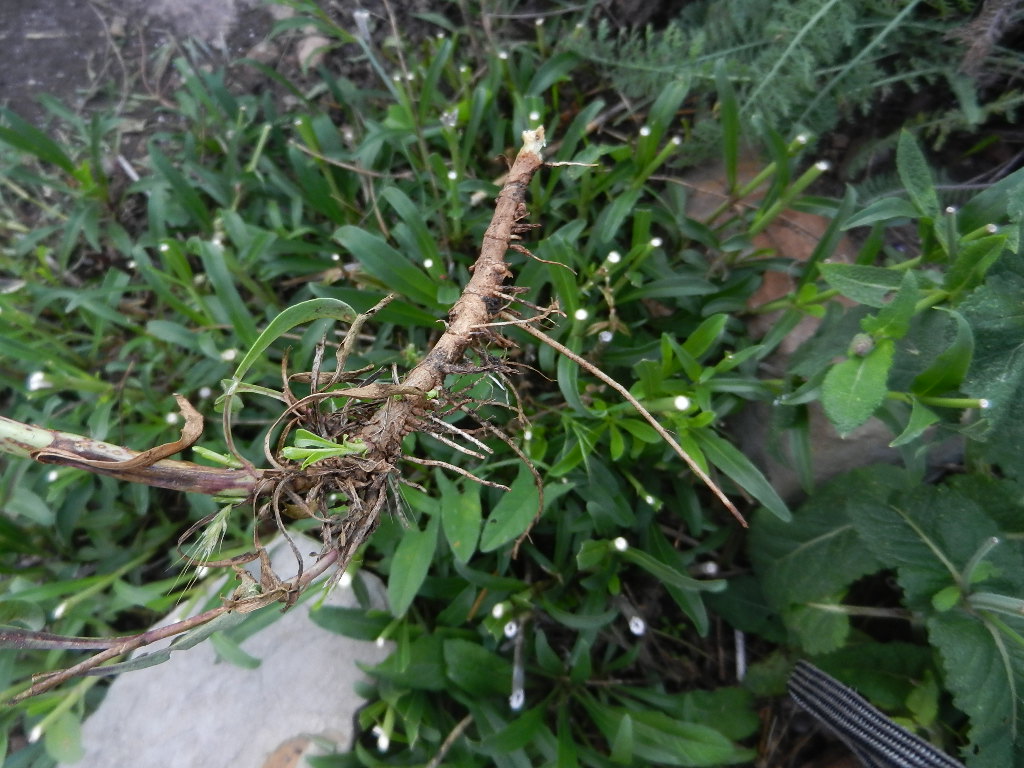When to divide a plant, or move a plant, may be the most common question we get here at the nursery. Division is one of the easiest methods of propagation. It’s faster than starting from seed, or taking a cutting, and if you start with a big plant you can often make many smaller ones to fill in your garden or share with friends. It can be scary, though, if you’ve never done it before. And not every perennial can be divided. If a plant grows from a tap root, like baby’s breath (Gypsophila paniculata), or poppy mallow (Callirhoe involucrata) you cannot divide it.
Plants that spread by forming more and more rosettes, little clumps of leaves with roots attached, like the penstemon in this picture below, can be divided.
The piece in the picture above, with roots and a few green leaves, will become a new plant once it is re-established in the garden. That little piece was pulled from the side of the plant, after loosening it with a trowel. You could also dig the entire plant and make lots of new plants by separating all the rosettes into separate plants. Penstemon can also be grown from seed, that is the more common method of propagation, but if you have a nice big clump in your garden, and you want more of the same color or species, division is a quick and easy method.
I am skirting the issue of when to divide, because it depends on so many factors. Generally you want to wait until after a plant has bloomed to divide it. Many of my penstemon bloom in June, and if I decided to divide them at the end of May, I might delay or lose entirely the flowers for that year. Still, if you need to move or divide a plant before it blooms, that’s not the worst thing you can do in your garden. More important than when is how. Once it is divided, it needs to be replanted quickly and kept moist while it is establishing in its new home. If you divide during a really hot, dry period, shading the divisions with something can help it recover, too.
When people talk about heirloom plants and pass-along plants, they are often talking about plants that divide easily. These are plants that neighbors and friends and family have shared with each other throughout the history of gardening. Many of these plants are very familiar to us: Iris, tall garden phlox, daylilies, and even some roses. Did you know that tall garden phlox is a North American native? When we first moved here, there were a few plants left from the previous home owners including the common orange daylily and a tall garden phlox that we called Grandma’s Garden Phlox. It’s very fragrant, and pretty mildew resistant, too. It survived years of this place being abandoned and rented and still flowers now, almost thirty years after I first saw it here by the back door. Here it is growing near the orange daylily.
Heirloom bearded iris are easy to share with friends. They are very forgiving plants. You can dig them, put them in a paper bag in your garage and days, weeks, even months later, remember them and plant them and they’ll survive. I don’t recommend that, though. As with any division, replanting sooner rather than later is key to having a happy new plant. The older, heirloom bearded iris seem to be much more adapted to Colorado’s climate than some of the new hybrids, and can survive long periods of drought. To bloom their best, though, they like regular moisture in the spring. (Don’t we all?)
Iris not only tolerate being divided, they need to be divided every few years or they crowd themselves so much they won’t bloom well. Because of that fact you might often find yourself the recipient of iris that someone else needed to divide. I’ve been lucky the last few years and had some heirloom iris given to me: Iris ‘Flavescens’ came from Bob Nold from a piece first rescued by Lauren Springer Ogden in Wyoming; Ann Hatcher sent me a box of iris filled with interesting colors, including a white iris with a red beard!; Iris ‘Wabash’ is a famous heirloom that CA Freeman just sent me. I have a similar iris, but not the true Wabash, it turns out. I’m grateful to have all of these new iris and hope that they flourish and spread so that in a few years I’ll need to divide them, too.


